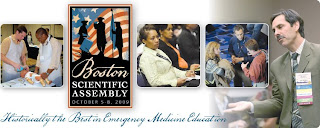 The ACEP Scientific Assembly is coming up next week in Boston. I am presenting 3 lectures.
The ACEP Scientific Assembly is coming up next week in Boston. I am presenting 3 lectures.- Acute Limb Ischemia
- Lifelong Learning and Self Assessment Review: Part 3
- Tricks of the Trade
I find that you can be the best speaker in the world, but if you have visually distracting slides, your talk comes out only average. These are only my opinions, and you should develop your own style and preferences.

1. Font consistency and visibility
- I typically choose a sans sarif font such as Arial. I find it easier to read on a screen. Less busy than sarif fonts such as Times.
- Be sure that you are using the same font throughout the slides. This is a pet peeve of mine...
- Be sure that the font size is large enough so that audience can read the slide from over 30 feet.
- Choose a non-busy dark background. Notice the great speakers will have a very unobtrusive dark background. The next time you are at one of Dr. Amal Mattu's talks, check out what background he uses. I think it's just a plain black background.
- Use only only a few text colors. I use 2-3. Generally they are yellow (headers), white (main text), and light blue for emphasis. These colors pop off a black or very dark blue background.
- Make the images large enough so that everyone can notice the details.
- Be sure images are high-resolution and not grainy. Another pet peeve of mine. It makes you look lazy if you have a fuzzy image of a xray, EKG, or clinical finding.
- Don't use an image if you don't need to. It's distracting.
- Referring back to yesterday's post about how our brain learns, the goal of teaching should be to maximize "germane load" (relevant information) and minimize "extraneous cognitive loads" (white noise which doesn't contribute to learning). To me, transitions between slides falls in the latter. This is also true for busy transitions between sentences.
- On busy slides with lots of text, I sometimes use a transition feature such that lines of text appear only when I talk about them.









